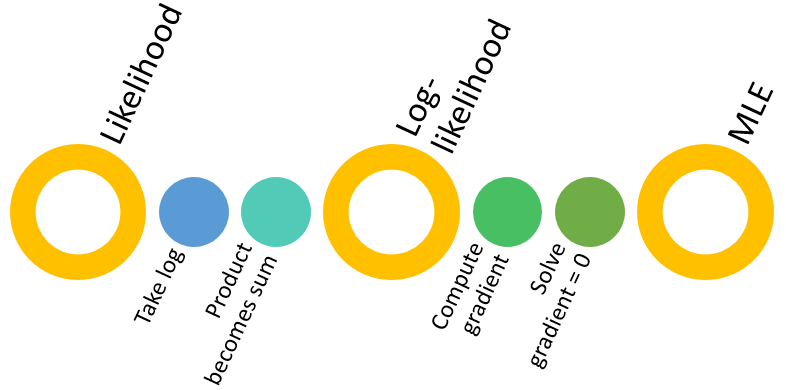This lecture deals with maximum likelihood estimation of the parameters of the normal distribution.
Before continuing, you might want to revise the basics of maximum likelihood estimation (MLE).
Our sample is made up of the first
terms of an IID sequence
of normal random variables having mean
and variance
.
The probability density
function of a generic term of the sequence
is
The mean
and the variance
are the two parameters that need to be estimated.

The likelihood function
is![[eq3]](/images/normal-distribution-maximum-likelihood__8.png)
Given the assumption that the observations
from the sample are IID, the likelihood function can be written
as![[eq4]](/images/normal-distribution-maximum-likelihood__9.png)
The log-likelihood function is
![[eq5]](/images/normal-distribution-maximum-likelihood__10.png)
By taking the natural logarithm of the
likelihood function, we
get![[eq6]](/images/normal-distribution-maximum-likelihood__11.png)
The maximum likelihood estimators of the mean and the variance
are
We need to solve the following maximization
problem
The
first order conditions for a maximum are
The
partial derivative of the log-likelihood with respect to the mean is
which
is equal to zero only
if
Therefore,
the first of the two first-order conditions implies
The
partial derivative of the log-likelihood with respect to the variance is
which,
if we rule out
,
is equal to zero only
if
Thus,
the system of first order conditions is solved
by
Thus, the estimator
is equal to the sample mean and the
estimator
is equal to the unadjusted
sample variance.
The
vectoris
asymptotically normal with asymptotic mean equal
to
and
asymptotic covariance matrix equal
to
![[eq19]](/images/normal-distribution-maximum-likelihood__26.png)
The first entry of the score vector
is
The
second entry of the score vector
is
In
order to compute the Hessian
![[eq23]](/images/normal-distribution-maximum-likelihood__30.png) we
need to compute all second order partial derivatives. We
have
we
need to compute all second order partial derivatives. We
haveand
Finally,
which,
as you might want to check, is also equal to the other cross-partial
derivative
.
Therefore, the Hessian
is
By
the information equality, we have
that
![[eq29]](/images/normal-distribution-maximum-likelihood__36.png) As
a consequence, the asymptotic covariance matrix
is
As
a consequence, the asymptotic covariance matrix
is![[eq30]](/images/normal-distribution-maximum-likelihood__37.png)
In other words, the distribution of the vector
can
be approximated by a multivariate normal
distribution with mean
and
covariance
matrix
StatLect has several pages that contain detailed derivations of MLEs. Learn how to find the estimators of the parameters of the following distributions and models.
| Type | Solution | |
|---|---|---|
| Exponential distribution | Univariate distribution | Analytical |
| Poisson distribution | Univariate distribution | Analytical |
| T distribution | Univariate distribution | Numerical |
| Multivariate normal distribution | Multivariate distribution | Analytical |
| Gaussian mixture | Mixture of distributions | Numerical (EM) |
| Normal linear regression model | Regression model | Analytical |
| Logistic classification model | Classification model | Numerical |
| Probit classification model | Classification model | Numerical |
Please cite as:
Taboga, Marco (2021). "Normal distribution - Maximum Likelihood Estimation", Lectures on probability theory and mathematical statistics. Kindle Direct Publishing. Online appendix. https://www.statlect.com/fundamentals-of-statistics/normal-distribution-maximum-likelihood.
Most of the learning materials found on this website are now available in a traditional textbook format.